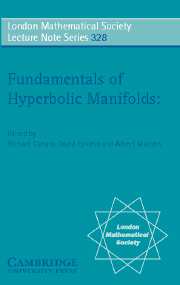Book contents
- Frontmatter
- Contents
- Preface
- Preface 2005
- PART I NOTES ON NOTES OF THURSTON
- PART II CONVEX HULLS IN HYPERBOLIC SPACE, A THEOREM OF SULLIVAN, AND MEASURED PLEATED SURFACES
- Introduction
- Chapter II.1 Convex hulls
- Chapter II.2 Foliations and the epsilon distant surface
- Chapter II.3 Measured pleated surfaces
- Appendix
- Addendum 2005
- PART III EARTHQUAKES IN 2-DIMENSIONAL HYPERBOLIC GEOMETRY
- PART IV LECTURES ON MEASURES ON LIMIT SETS OF KLEINIAN GROUPS
Appendix
Published online by Cambridge University Press: 05 November 2011
- Frontmatter
- Contents
- Preface
- Preface 2005
- PART I NOTES ON NOTES OF THURSTON
- PART II CONVEX HULLS IN HYPERBOLIC SPACE, A THEOREM OF SULLIVAN, AND MEASURED PLEATED SURFACES
- Introduction
- Chapter II.1 Convex hulls
- Chapter II.2 Foliations and the epsilon distant surface
- Chapter II.3 Measured pleated surfaces
- Appendix
- Addendum 2005
- PART III EARTHQUAKES IN 2-DIMENSIONAL HYPERBOLIC GEOMETRY
- PART IV LECTURES ON MEASURES ON LIMIT SETS OF KLEINIAN GROUPS
Summary
The lipschitz property
In our investigations, we will stick to metric spaces where the metric is equal to the infimum of the lengths of rectifiable paths connecting two points. These are called path spaces and the metrics are called path metrics. Nearly all the time we will be working with the most common type of path space, namely Riemannian manifolds. In that case the original definition of the length of a (smooth) path is given by integrating the norm of the tangent vector to the path, the metric is given by the infimum of the lengths of smooth paths, and a short proof is needed to show that this metric is a path metric.
We want to talk about lipschitz maps and vector fields. There are a number of slight but annoying variations in the possible definitions one might choose. These differences arise from the fact that a subset U, connected by rectifiable paths, of a path space M, has two distinct metrics on it. The metric dM is measured using all paths in M, and the metric dU is measured using all paths in U. Thus if x, y ∈ U, dM(x, y) ≤ dU(x, y), and in general we will not have equality.
Definition. Let ϕ: U → V be a map between two metric spaces. We say that ϕ is K-path-lipschitz if for any rectifiable path γ in U, length(ϕ ∘ γ) ≤ K length(γ).
Information
- Type
- Chapter
- Information
- Fundamentals of Hyperbolic ManifoldsSelected Expositions, pp. 239 - 254Publisher: Cambridge University PressPrint publication year: 2006
